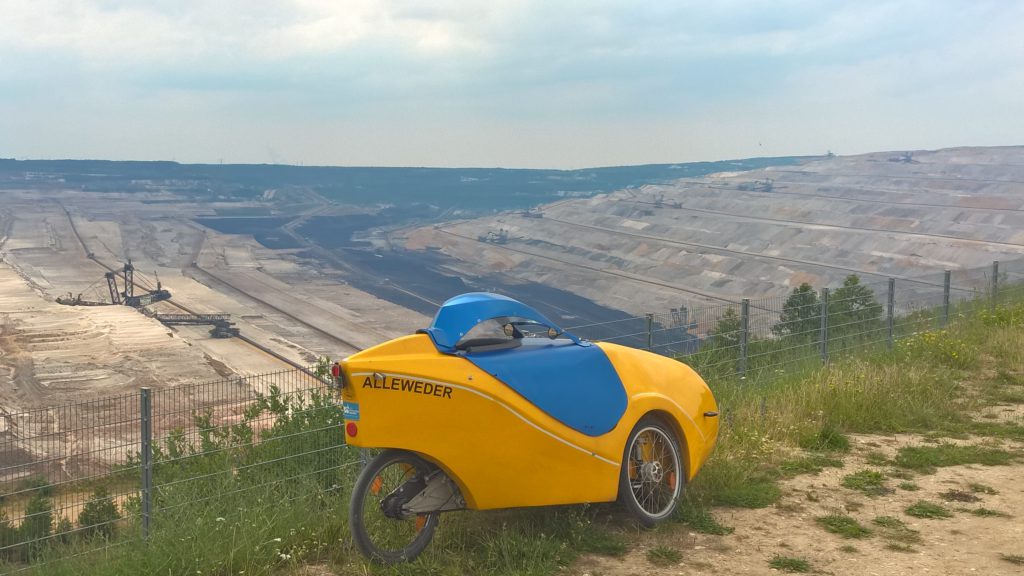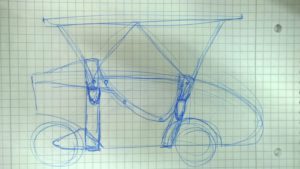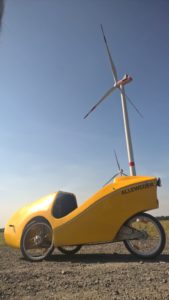This is about an Alleweder A6 pedelec turned into a solar-electric, post-futuristic vehicle by adding a solar roof. The velomobile is equipped with a pedelec-standard electric drivetrain already (250W Bafang BBS01 crank-motor and a 36V 33Ah Li-Ion accumulator).
So, this is where we start at:

This is the vision:

As a post-futuristic act, I claim velomobiles – like this Alleweder A6 – to be the best choice for long distance, individual transportation (short distance just the same anyway). Velomobiles will be the standard mode of transportation for post-futuristic man. On high-quality cycle paths that cover the land, velomobiles will cover distances of up to 400 km per day. On 100% renewable energy. 100% cradle to cradle. 100% decentralised. They will obtain this ability by running on electric assist that pushes the velomobile to speeds up to 50 km/h. The necessary power will be supplied by solar power. Either by solar-cells that are carried along the way or by home-made photovoltaic power that is fed into the grid and then charged into the velomobile during overnight stops.
Parts of this vision are beyond my control in a world that is still mostly addicted to futurism and with most people feeling unable to change their routines into more sustainable ones. I can – however – get started with this post-futurictic vision, see how far I get and turn the project into a lighthouse project that will spread the word of the possibility and about what great a possibility this offers. And how easy it is to do.
Here is how I got the idea:

I used to ride this Alleweder for a couple of years already. And while it has served me very well on thousands of journeys – most of them only to work and back – the ones that fascinated me most were the „long“ inter-city rides I undertook a couple of times in a year. The ones that were done in blazing sunlight on the shadowless plains of the coal-mining-deserted land between Aachen and Cologne stuck to my memory the most.
Having spent quite some post-climate-change summer-hours on journeys out there – I can safely say – transformed me into a Sonnenanbeter. I stand in awe, eye to eye to a hot and dry future that is about to begin. Being out there on a bicycle route you are oftentimes alone for kilometer after kilometer while the masses of people commuting between the cities are stuck in their behemoths on the highway just a couple of kilometers further south. The hot wind, the neverending sunshine of an endless day mid-june. This feels pretty post-civilisatory. Nevertheless, since I have hopes that this mode of transportation will become a normal mode of transportation and there will be more traffic on the cycle-paths and less on the highway: Post-futuristic. This is what it is going to be. You want to take a ride that is inter-city or further: You won’t be able to use a locomotive-sized bulk of metal and plastic and load a month’s worth of chemical energy* into its tank just to burn all of it to get one person in an embarrassingly badly designed vehicle up to ridiculous speeds. Here’s how you will do it instead.
*For reference see: Hans-Peter Dürr „Die 1,5 Kilowatt-Gesellschaft“

So far I have only undertook inter-city rides with my set-up. But I am now planning to take a longer trip, possibly trans-european. That at least is what I want to be prepared for once I take off. I identified one technical problem about this: To autonomously manage distances greater 150 km/day I need to be able to carry more energy with me than my lithium-ion battery is able to store (1,2 kWh). Either I have to invest in more battery mass or I have to charge on the way. The charge on the way option does seem a lot more promising. Charging on the way (using solar cells) will not just grant me higher range but also the possibility to charge the battery if no access to the electricity grid should be available. Given the plan to stay within the limits of Europe with its narrow mesh of infrastructure and high population density all over the place this doesn’t seem like a valuable advantage. It does – however – add one whole dimension of autonomy that has not been available to me on my trips before. Since energy is one of the big dependencies we face I think it is well worth investigating and experiencing energy autonomy by local production once it is so close at hand.
And then there was…the Sun Trip
There’s this dude Justin who – together with his then fiancee – built a post-futuristic vehicle: Three wheels, two seats, one big solar roof to power all the electrics of this human-electro powered hybrid. Then they took this vehicle on the 2018 Sun Trip (bicycle rally from France to China) and made it from France well into Iran before they had to return home for their planned wedding. And do I want to be cool as that and build and ride my own post-futuristic vehicle? Yes, I do.
Why am I not using a bicycle without e-assist/without the need to charge to fully get rid of the need for electricity?
I don’t believe in a post-futuristic future in which everybody turns into a bicycle enthusiast and like to take a training session whenever they want to get anywhere. In a post-futuristic future there will be a need for personal transportation and since this cannot be maintained by a car (what futurists understand of as car) there’s got to be something else. The low-tech, low-ressource, decentralised and clean solution to this problem is a velomobile that offers the rider an adequate amount of safety, comfort and thus, assistance. So, even if there are 100% human powered vehicles that can go faster than my pedelec-velomobile while having no need for a source of power other than healthy food: I will still use a post-futuristic vehicle just because this is a post-futuristic experiment and not a bicycle challenge. In a post-futuristic future the maximum speed of such vehicles will no be limited to 25 km/h anyway. And once this limit is fixed to the post-futuristic needs, this mode of transportation is going to be faster than any amateur-cyclist anyway.
jump to top